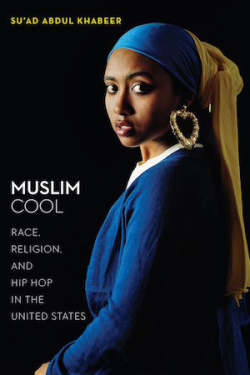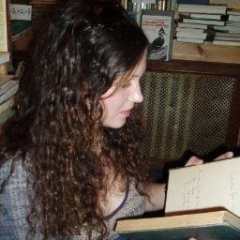Islam Meets Hip-Hop: An Unorthodox Beat

To Purdue scholar Su’ad Abdul Khabeer, hip-hop and American Islam are a natural match: both flourish beyond, and comment upon, a hostile status quo. And both provide a place of refuge and expression for African Americans held at the margins. Abdul Khabeer explores the rich relationship of hip-hop to Islam in her fascinating new work, Muslim Cool (from NYU Press).
Muslim Cool utilizes interviews, studies, and the scholar and artist’s own experiences within the Muslim community to bring unorthodox cultural and religious expressions to life—drawing Islamic theological concepts out from hip-hop performances, both lauded and lesser-known, and showing how the art form was utilized to carve out a space for young American Muslims in search of justice and peace. Hers is an intricate and illuminating study, with much to say about continued inequalities, both in the United States and within Islam itself. We asked Su’ad about her book—and about how Muslim Cool artists might respond to coming shifts in Washington, D.C.
Why is hip-hop uniquely poised to do the complex work of confronting both religious orthodoxy and a racist political system?

Su'ad Abdul Khabeer: Black Muslims 'respond to conditions of injustice by articulating alternatives.'
Great question. To my mind, especially as it relates to Muslim Cool, a lot of the complex work hip-hop enables is the result of its relationship to Black Islam. “Black Islam” is a big tent term I use to describe the range of ways US black Americans have engaged Muslim beliefs and practices. This includes groups like the Ahmadiyya Muslim Community and the Nation of Islam, as well as Sunni and Shi’i orthodoxies.
All of these movements share a pointed concern with the realities of black communities living in conditions of systemic inequality and they respond to conditions of injustice by articulating alternative cosmologies, politics, and social norms geared toward individual and community empowerment. This concern and commitment of Black Islam was picked up by the hip-hop generation and continues to express itself in hip-hop music and culture. Yet, also under this tent are movements that some consider unorthodox.
This is because of how they assess actual religious teachings, but also more broadly because of how anti-black racism within Muslim communities delegitimizes all ways blacks practice Islam, irrespective how close or far it aligns to orthodox global Muslim tradition, i.e. because black people do it, it is always religiously suspect.
Consequently, when hip hop engaged Black Islam, it did so through this “heterodoxy” (real and alleged). It is this convergence that makes hip-hop so uniquely positioned and for the young Muslims I worked with this meant they found themselves inspired to confront anti-blackness as Muslims through the various traditions of Black Islam—orthodox, heterodox, and otherwise. They identify these traditions as legitimate resources through which they interpret their own Muslim identity, thereby challenging ideas of what counts as “Islamic.”
How, if at all, do you imagine your work being affected by, or responding to, the incoming administration? What about the work of other artists who are Muslim Cool?
In the final paragraph of my book I state: “The future of Muslim Cool, and of Muslims in the United States more broadly, lies in its investment in its alterity—the ability to imagine, articulate, and participate in alternate choices for resistance and political vision.” This statement was written well in advance of the election of Donald Trump to the US presidency yet its message remains just as relevant.
I think it is undeniable that the incoming administration, in its rhetoric and policy, is trying turn back the hands of time. It seeks to usher in a status quo that legitimates the evisceration of rights—including the right to be secure against all forms of state and vigilante violence—of people of color and other marginalized groups in the United States. This will affect my work and those of artists who are Muslim Cool by making our work every more urgent and increasing the risk involved in doing it. Yet, and these are the very last words of Muslim Cool, while the risk is very real, “we have nothing to lose but our chains … we gon’ be alright.”
For readers interested in a lightning-swift introduction to Muslim Cool in action: which artists, albums, and performances would you recommend they check out?
Although it’s not the oldest out there, I’d definitely say start with Yasiin Bey’s (formerly Mos Def) 1999 album “Black on Both Sides.” From the album’s very beginning, which opens with his whisper of the Quranic verse “Bismillah ar-Rahman ar-Rahim” (In the name of God, The Most Gracious, The Most Merciful) to its very last song, that actually has no rhymes but is an instrumental jazz-inspired hip hop track, this album and artist epitomizes Muslim Cool.
In addition to this artist I would also point to more classic and legendary artists such as Rakim and the groups Brand Nubian, Poor Righteous Teachers, and A Tribe Called Quest. In the contemporary scene, I’d also recommend Amir Sulaiman, whose Meccan Openings album trilogy is a masterpiece, the grammy-nominated Maimouna Youssef, the duo The Reminders, Brother Ali, Lupe Fiasco, Jay Electronica, Omar Offendum, and Narcy.
Also, Native Deen, Bay-area based artist Alia Sharrief, and Queens-bred Miss Undastood, who was recently featured on the new song “Crown” are worth checking out as well.
There are many others but after going through this sampling you’ll be able to see Muslim Cool and the influence of Black Islam elsewhere like in the music Lauryn Hill and Kanye West and in the most recent appearance of Dave Chappelle and A Tribe Called Quest on Saturday Night Live, which featured performances by five Black Muslim men (Chappelle, Q-Tip and Ali Shaheed Muhammad of ATCQ, Busta Rhymes and Consequence) on the eve of Trump’s election.
Can you tell us about the experience of working with New York University Press to bring Muslim Cool to print?
To be honest, the experience was pretty great. When my book was just a proposal and few chapters I was fortunate enough to have the work considered by two other presses. They were all interested in the book but one of the things that made NYU standout was that their interest was matched with plans that would get the book out sooner rather than later. This was important to me professionally (vis-à-vis tenure deadlines) but also as scholar who was eager to make my research available and put out my ideas out in the public square. As a first-time author I also appreciated their responsiveness to all my many many questions and even now that the book is out I am finding them really supportive in terms of spreading the word on Muslim Cool.
Can you tell us a bit about your project Sampled?
Sampled: Beats of Muslim Life is a one-woman solo performance piece I created based on many years of research among US Muslims. For me, Sampled is another way of telling the complex and dynamic story of Muslim Cool. The title, Sampled, is a reference to how both hip hop artists and academics cite others. Hip hop artists “sample” or take excerpts from previously recorded songs in the composition of their own music.
Similarly, academic scholars are also expected to “sample” the ideas of other intellectuals in the process of constructing their own. Likewise, the narratives of my performance ethnography are themselves samples—excerpts and examples—of multiple stories I encountered in the field.
The performance consists of a series of vignettes akin to scenes in a play, although without a linear narrative structure, that uses movement, theater and poetry to ethnographically represent my research and findings to audiences within and beyond the academy, which is very important to me. I’ve had the opportunity to perform Sampled in universities and community-based venues and I’m planning to more shows in 2017. You can find a trailer here.
What projects are you working on next?
Like the classic overachiever I’ve got a lot of pots on the fire—that is to say, I’m working on quite a few projects. I continued to develop and perform Sampled and I also have a short film project on Black Muslim style that I am working on as well. I am also working on expanding the work and reach of the website I founded Sapelo Square.
Sapelo is fairly new, we began in May 2015, and it is the first of its kind—the first website to focus on Black Muslim life in the US in a way that is both critical and accessible. For my next book project I’m really interested in the contrast between black resistance and black imperialism, namely how do black Americans push back against state power and also in what ways do they choose to advance it.
You can follow Su’ad Abdul Khabeer on Twitter @drsuad.

Michelle Anne Schingler is the managing editor at Foreword Reviews. You can follow her on Twitter @mschingler or e-mail her at mschingler@forewordreviews.com.
Michelle Anne Schingler
